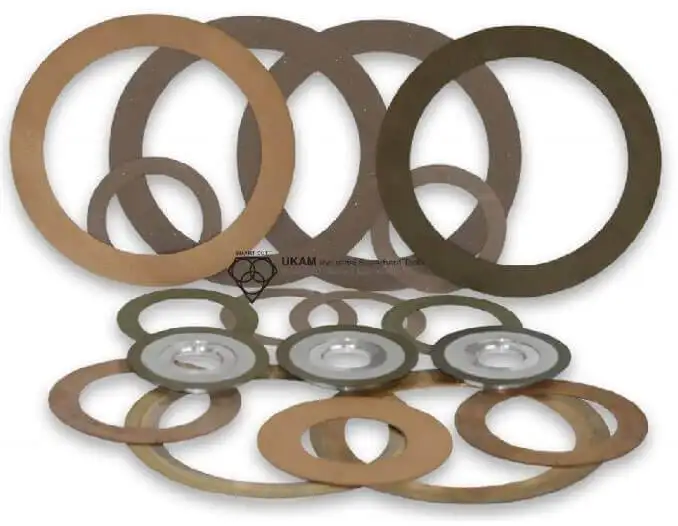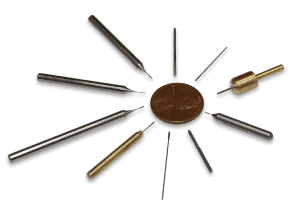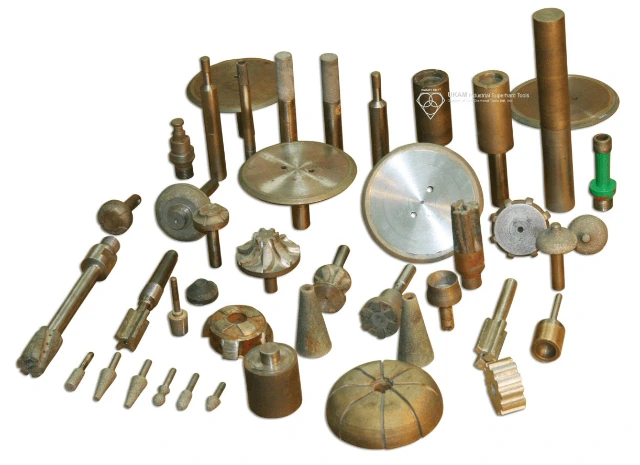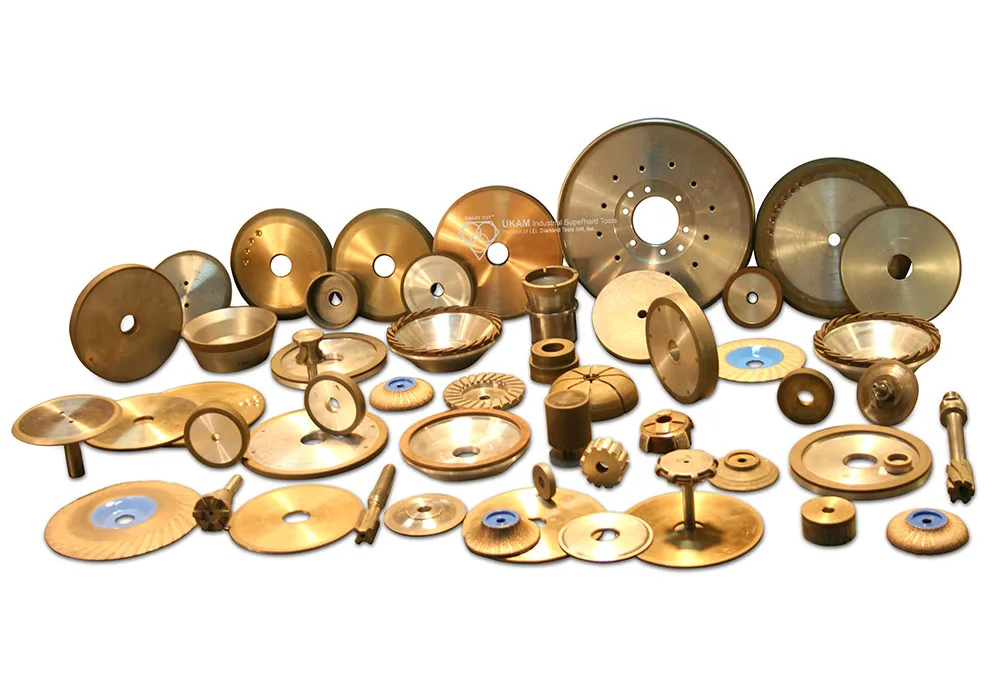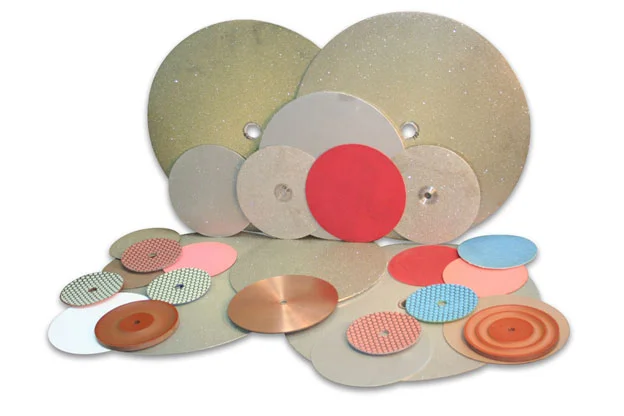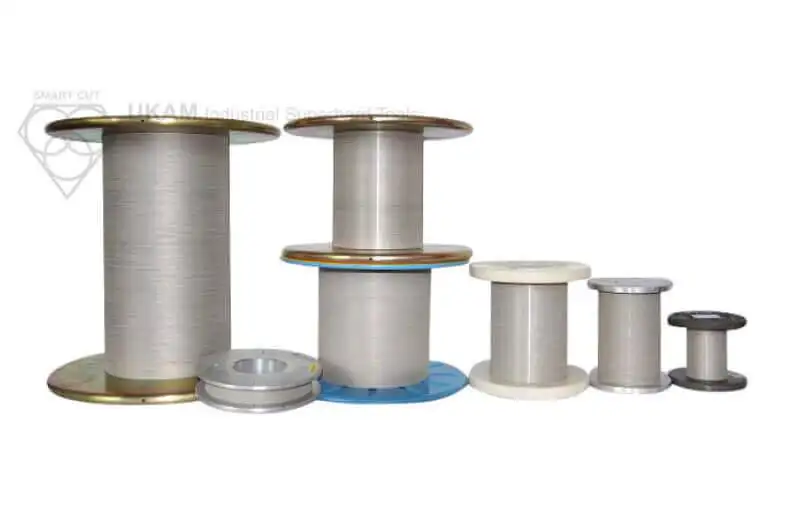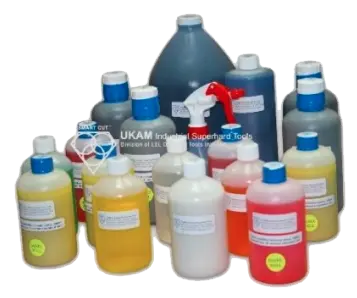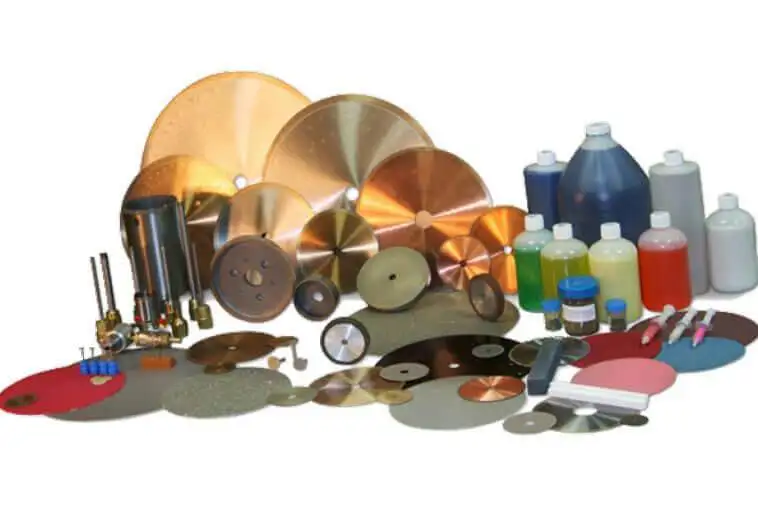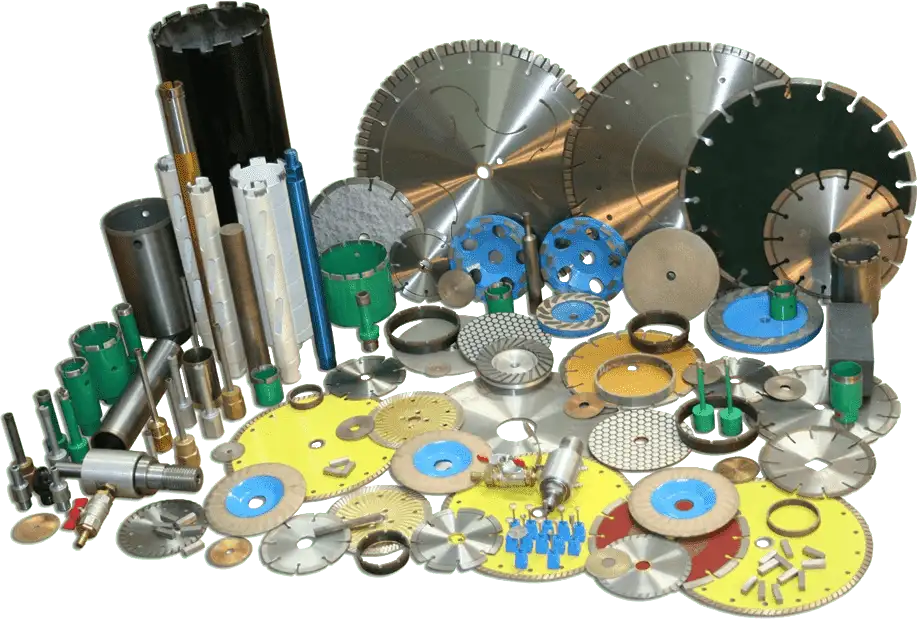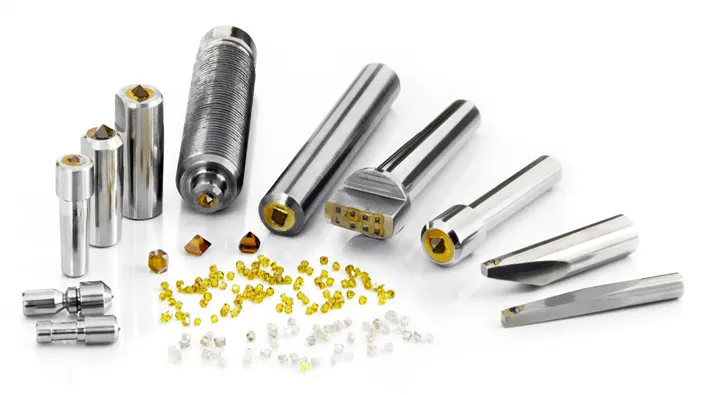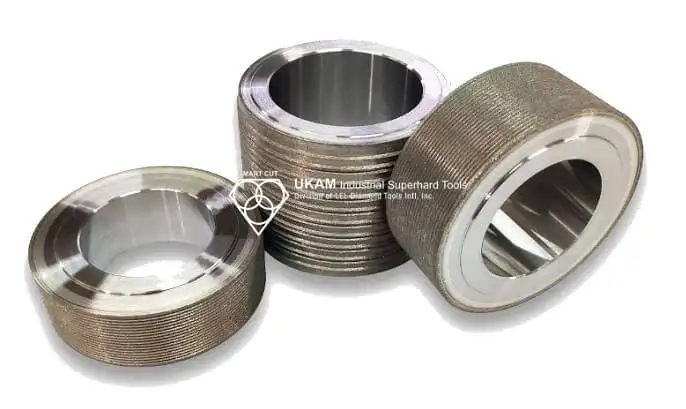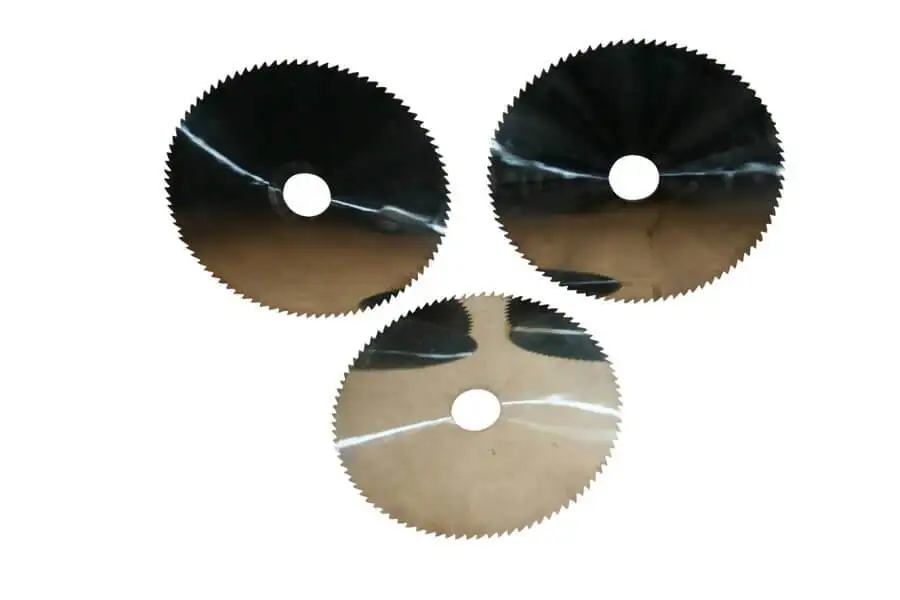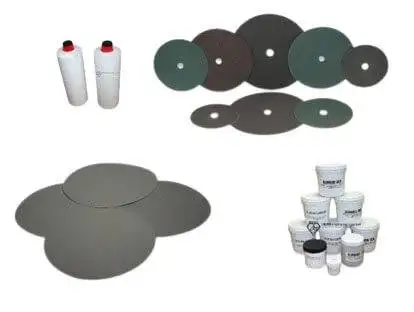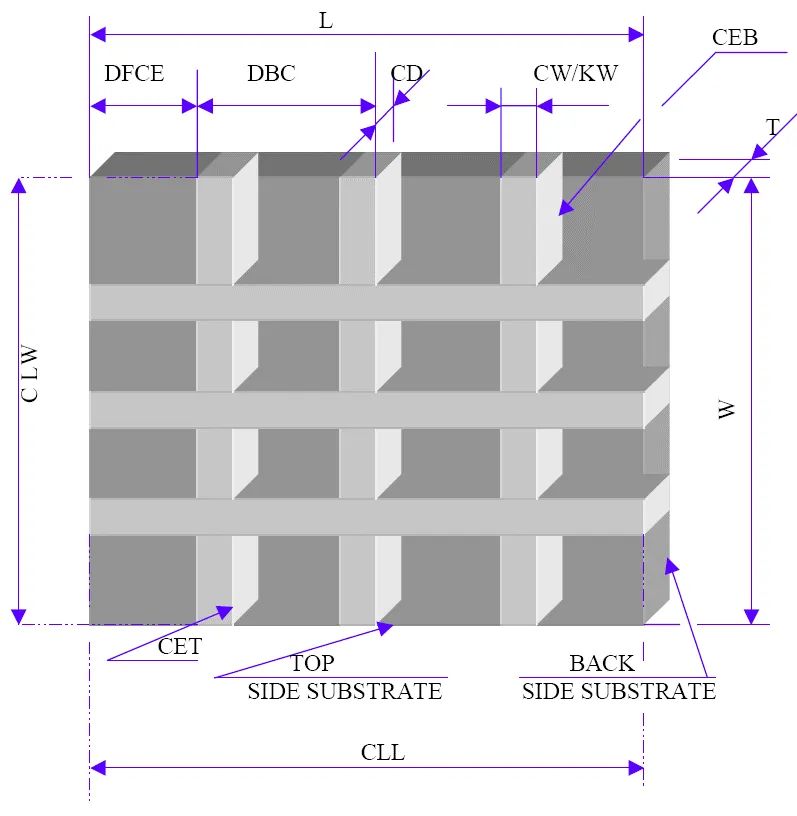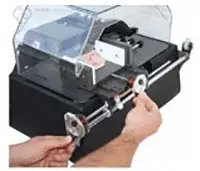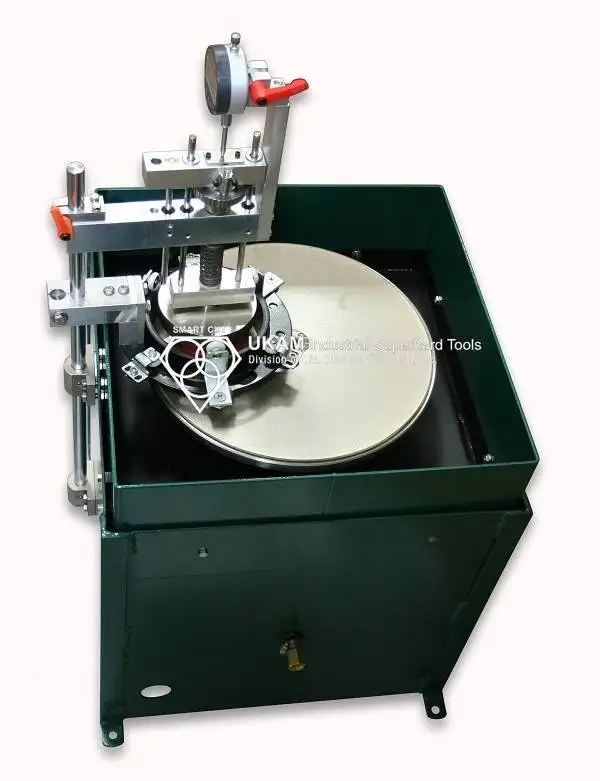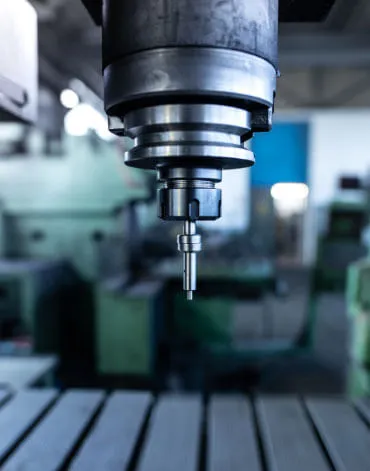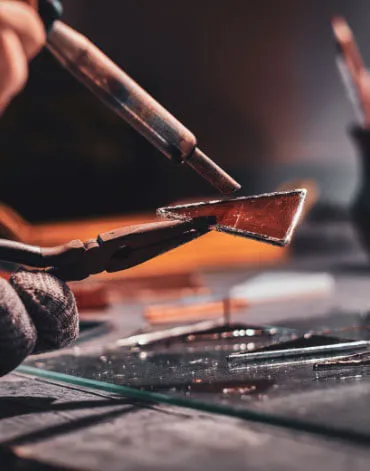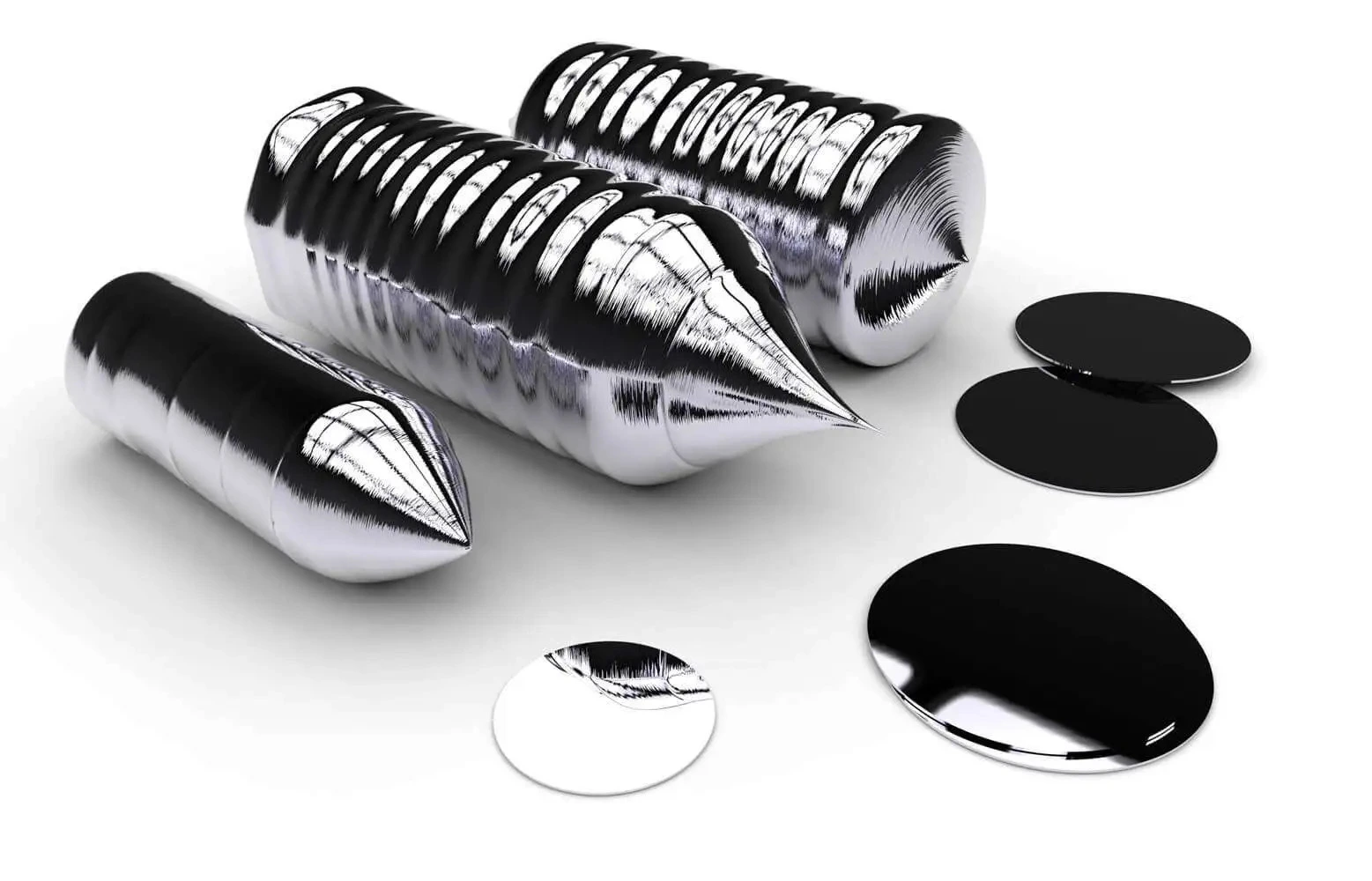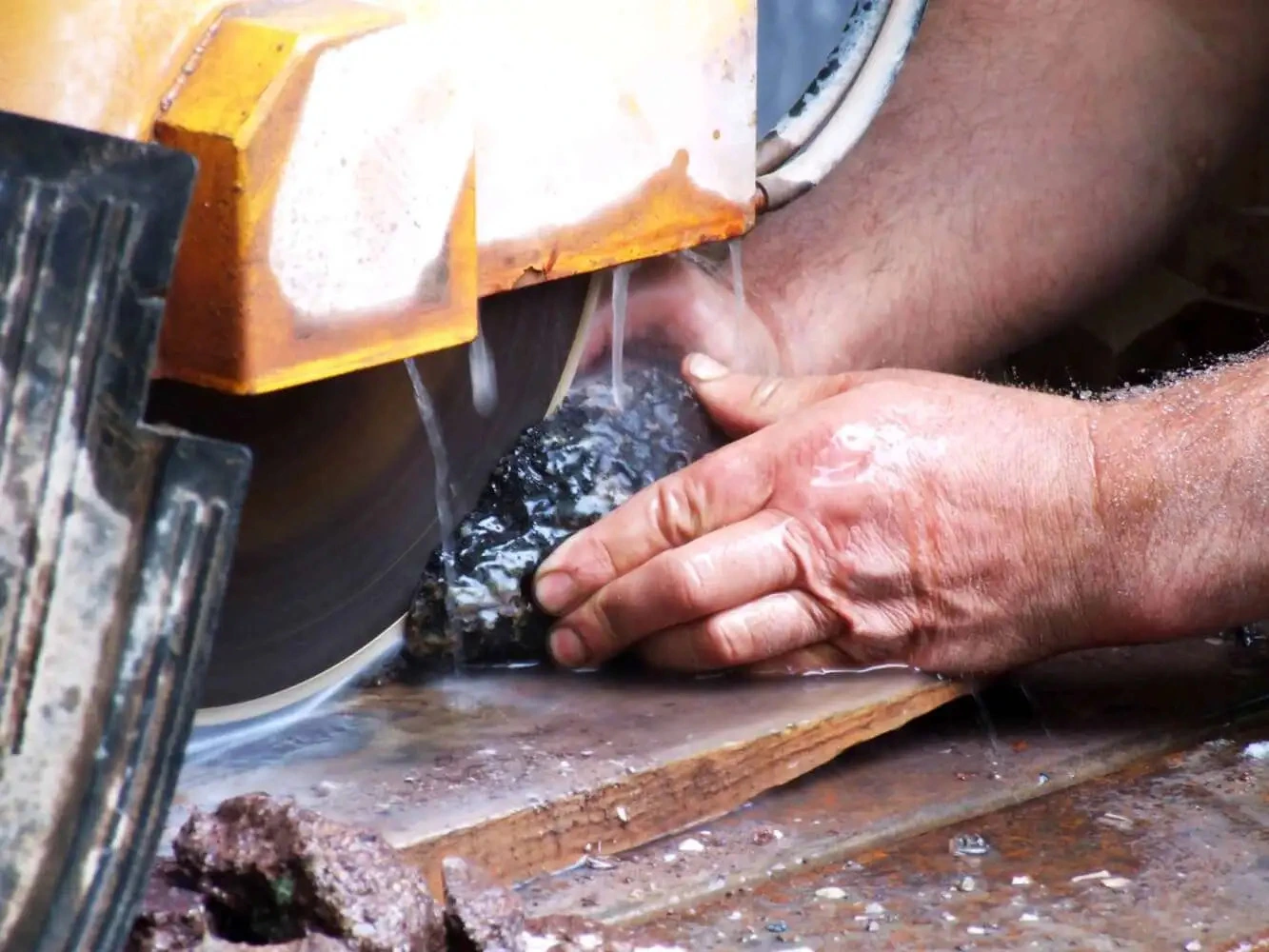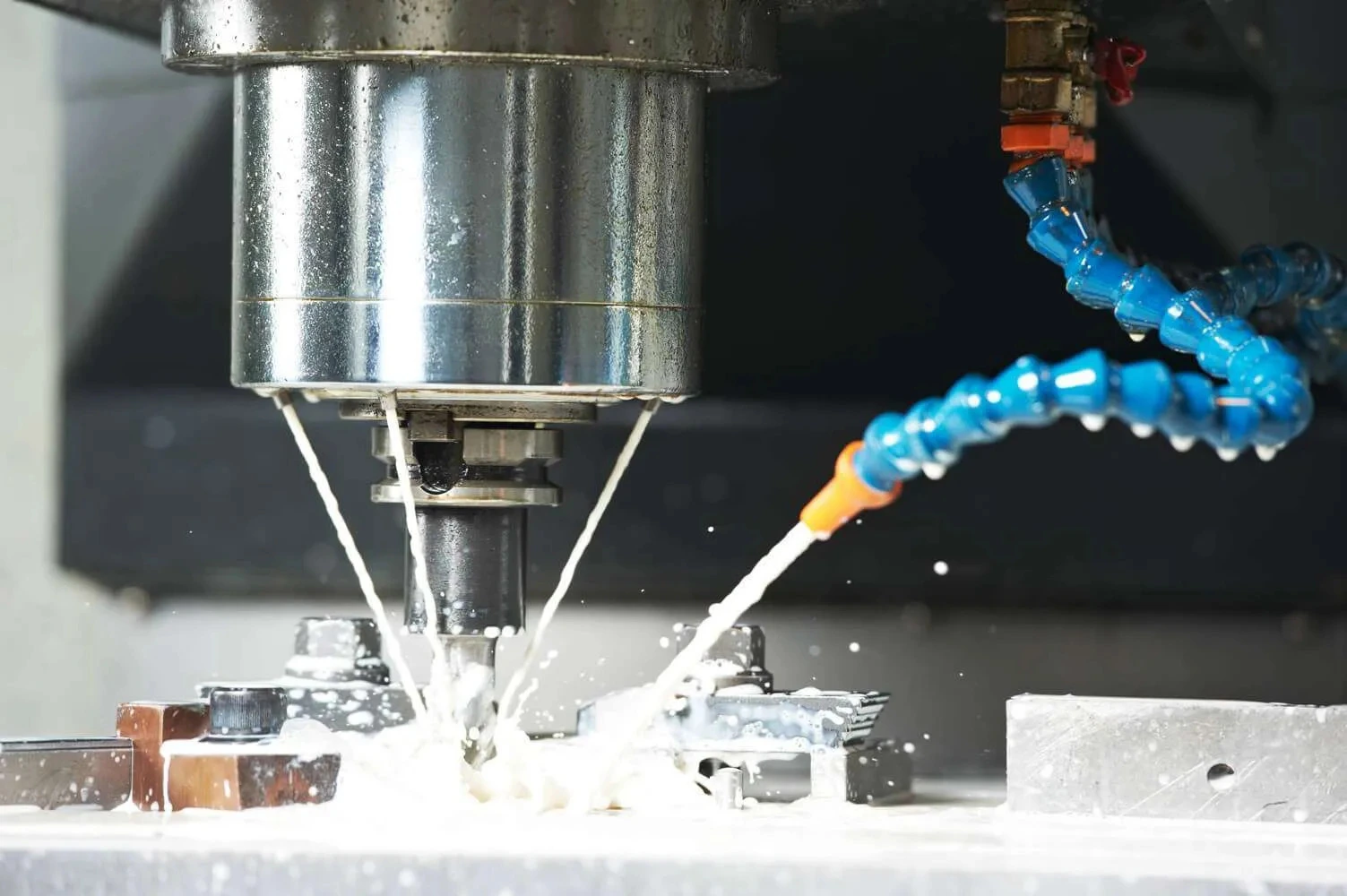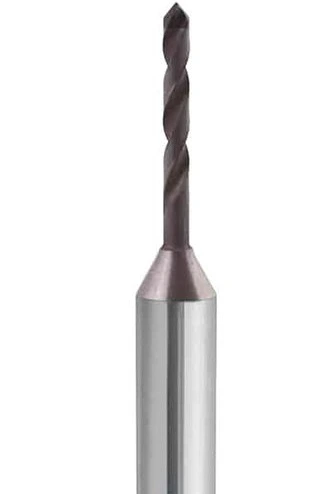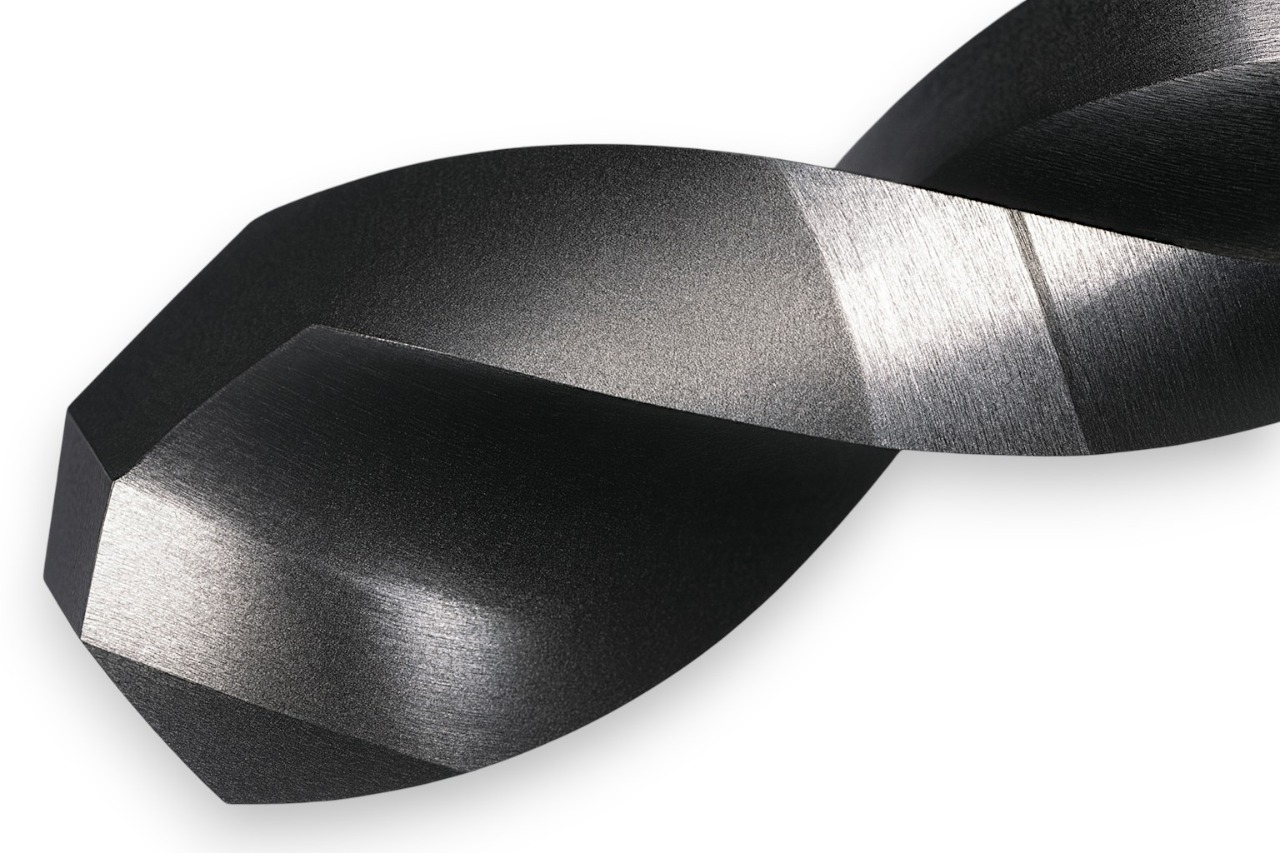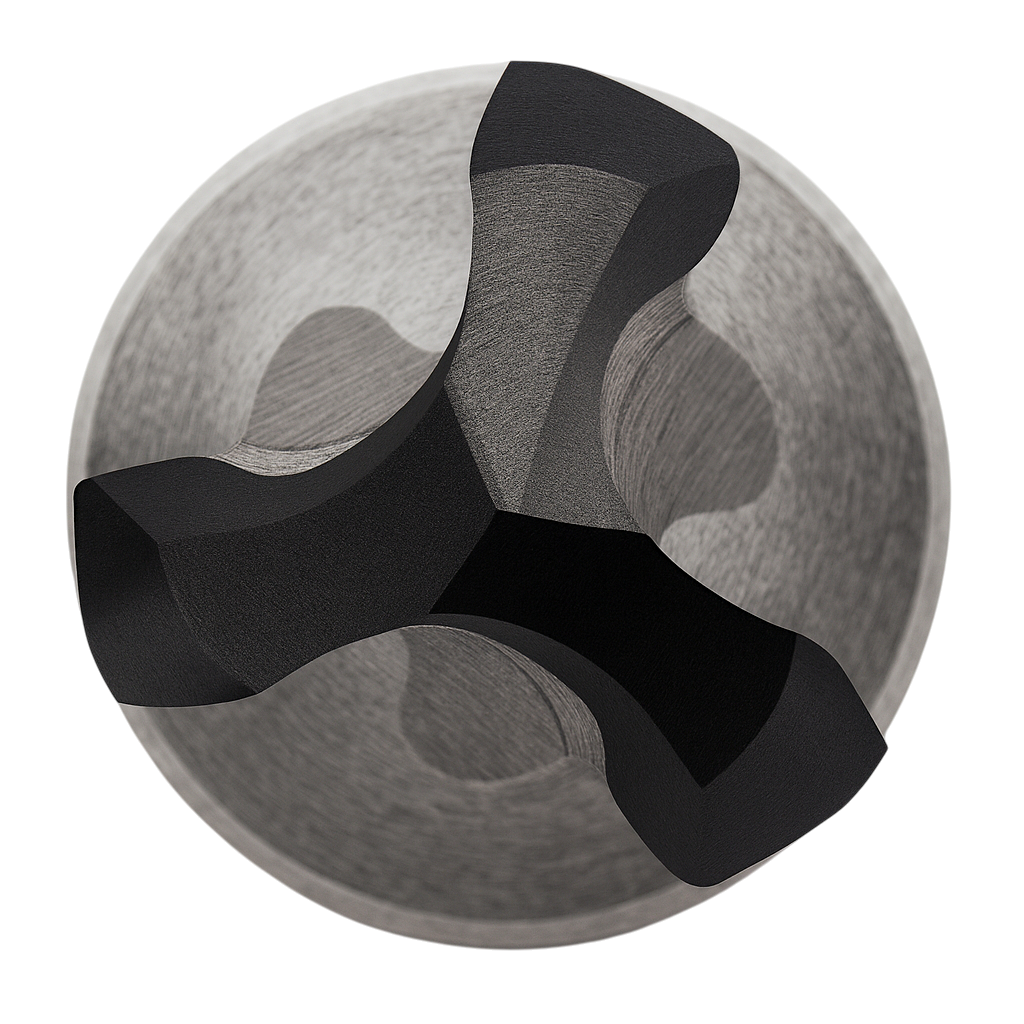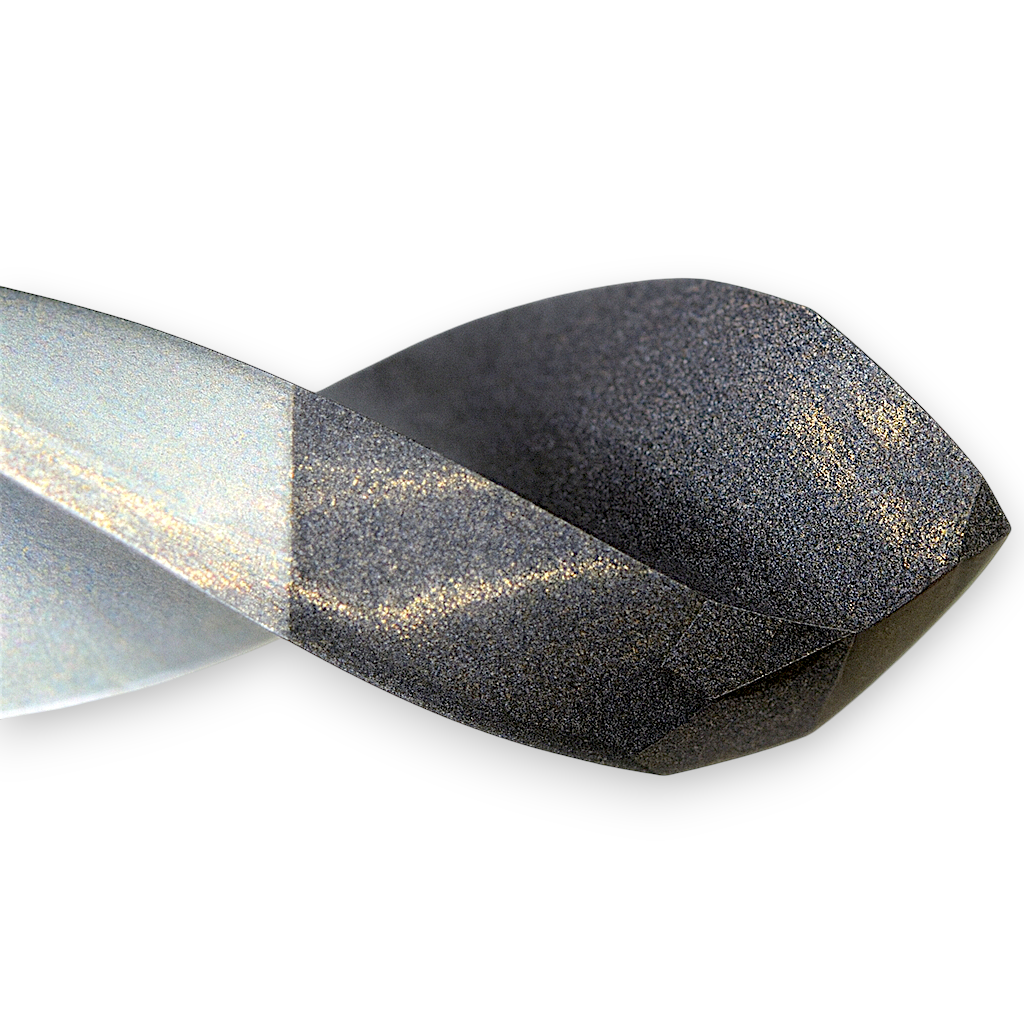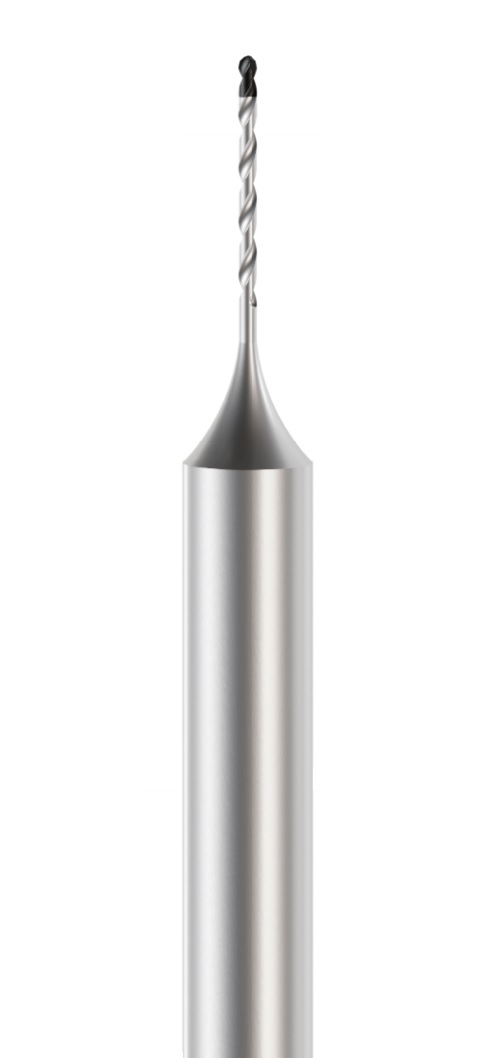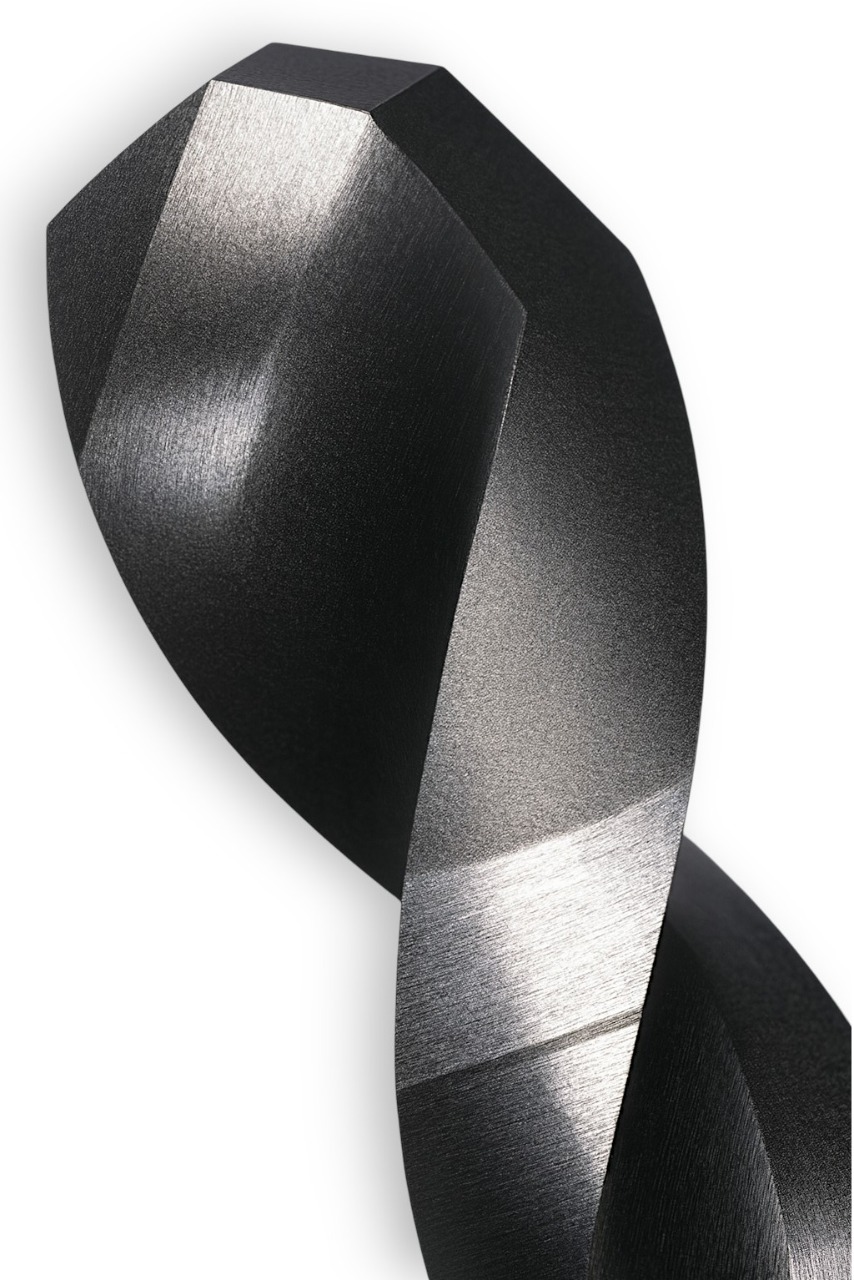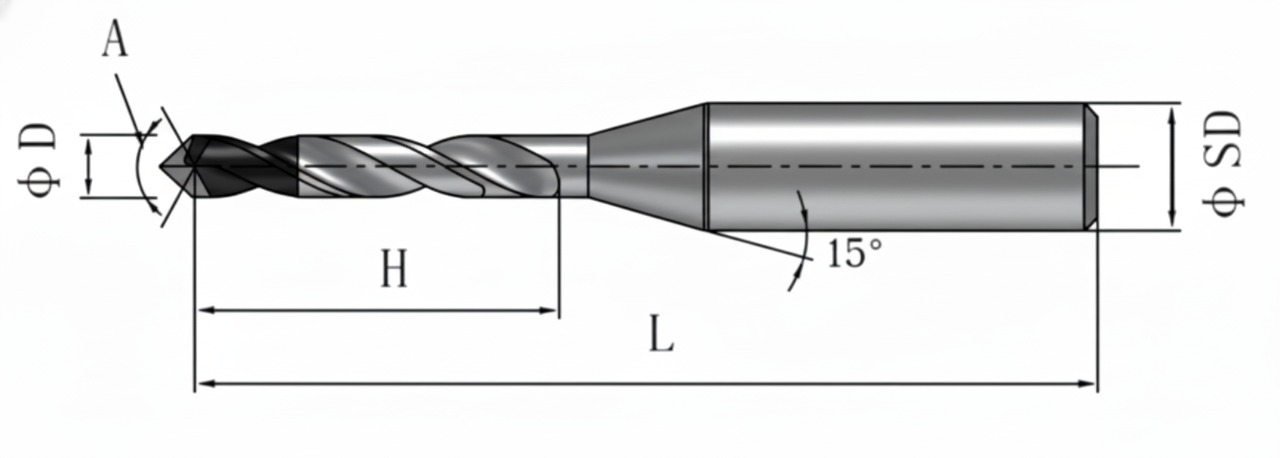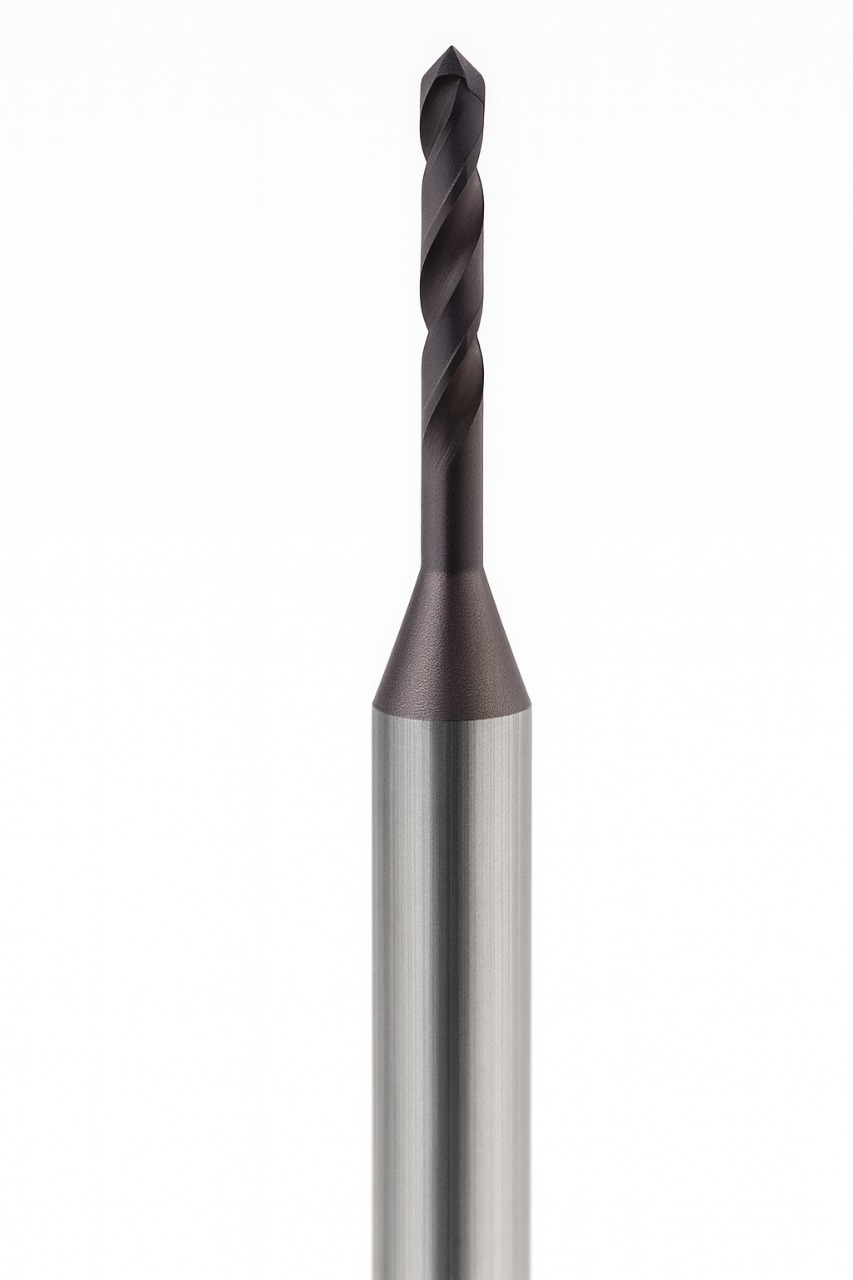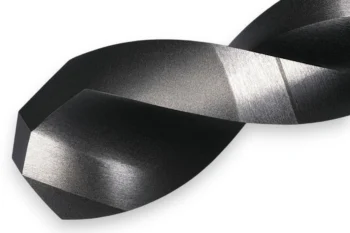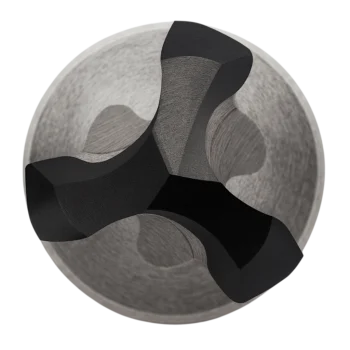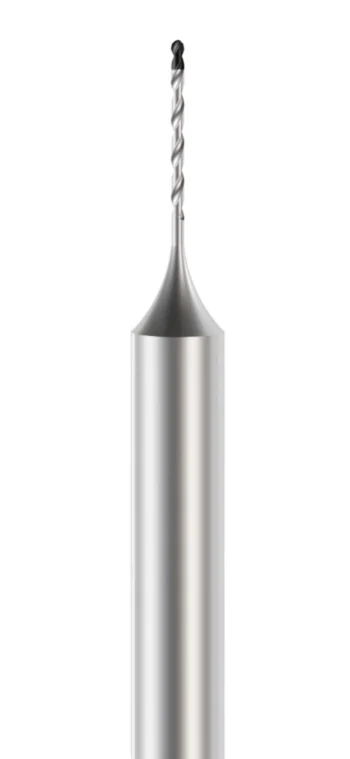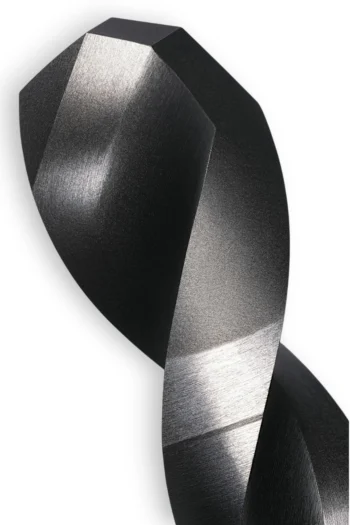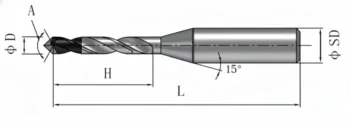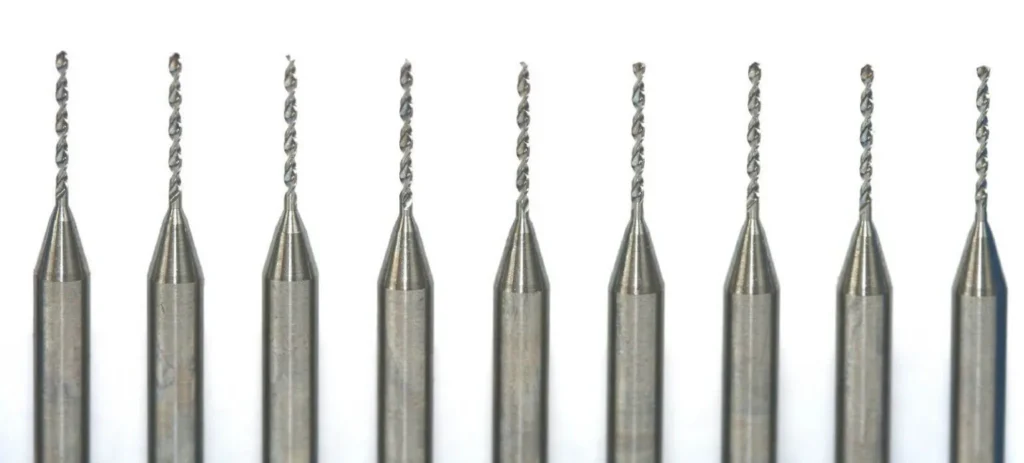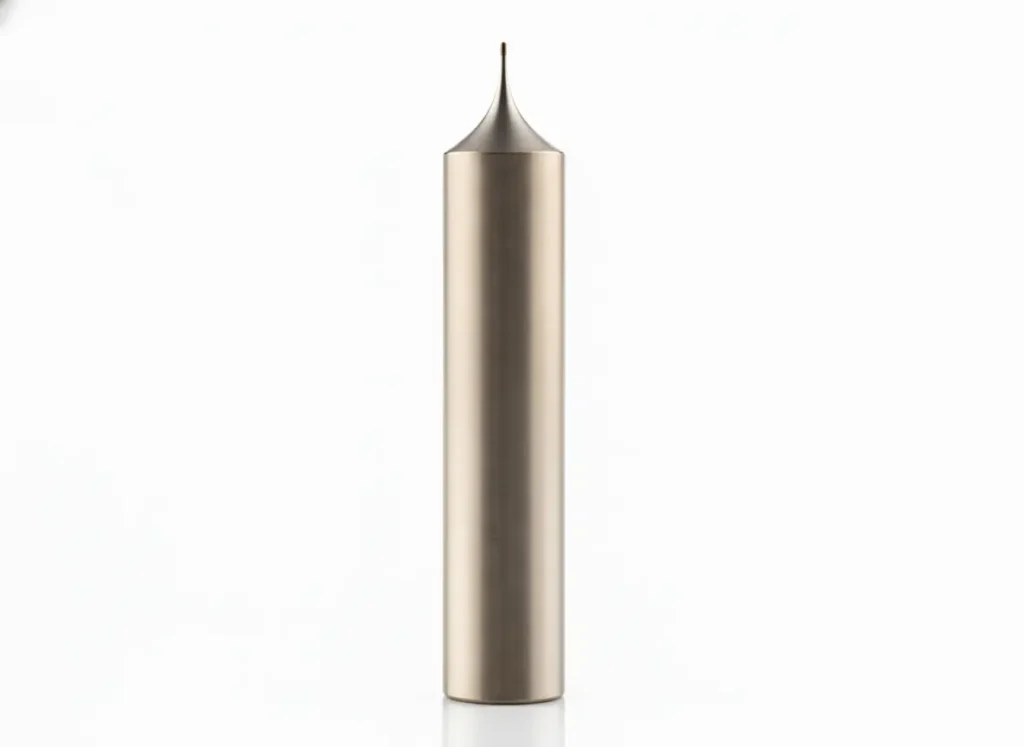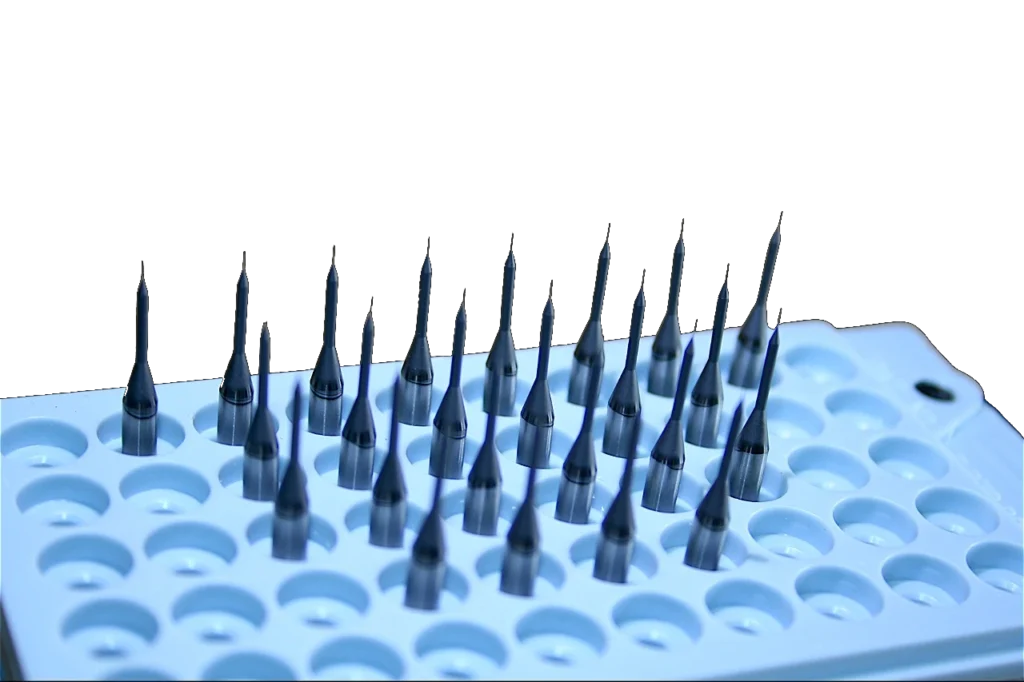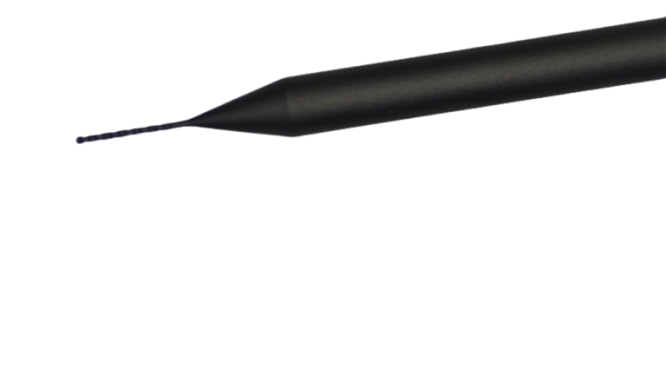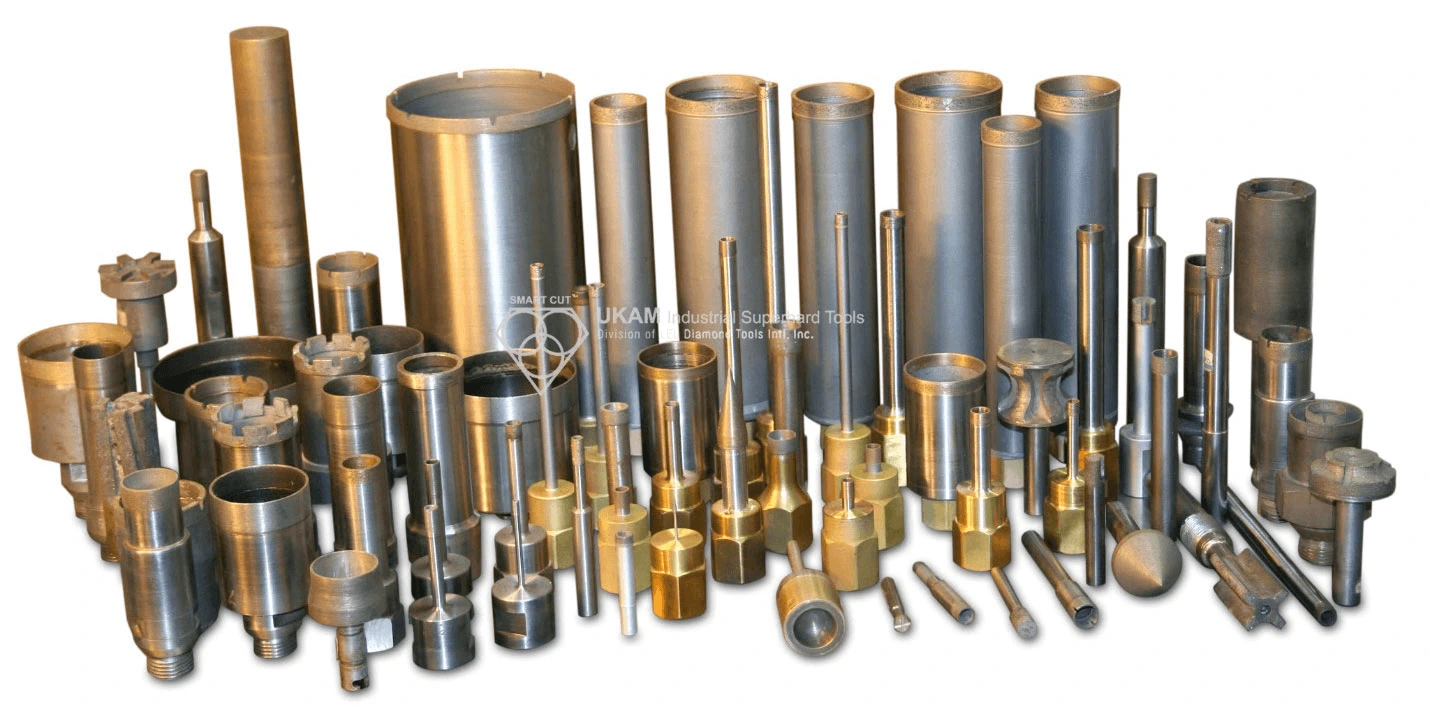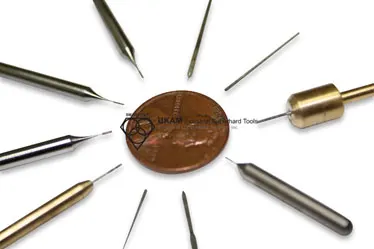-
0 items in quote
No products in the Quote Basket.
SMART CUT® PCD (Polycrystalline)
Diamond Micro Drills
SMART CUT® PCD (Polycrystalline Diamond) Micro Drills are precision-engineered tools designed for applications that demand exceptional hardness, wear resistance, and dimensional accuracy. They are available starting from 0.4 mm in diameter, with a wide selection of head lengths and standard shank diameters of 3 mm and 3.2 mm. Each drill features a sintered polycrystalline diamond tip bonded to a carbide or tungsten substrate, providing superior rigidity, heat resistance, and extended tool life.
These micro drills are widely used in the semiconductor, electronics, EDM electrode manufacturing, and die and mold industries. In semiconductor production, they are used for machining monocrystalline silicon, inspection and cleaning jigs, and precision fixture fabrication. In EDM electrode manufacturing, they are ideal for drilling graphite electrodes and other hard-to-machine materials that quickly wear down conventional tools.
DESCRIPTION
SPECIFICATIONS
FREQUENTLY ASKED QUESTIONS
INDUSTRIES USED IN
ACCESSORIES
USAGE RECOMMENDATION
DESCRIPTION
Typical materials machined with SMART CUT® PCD Micro Drills include monocrystalline silicon, quartz, fused silica, zirconia, aluminum oxide (Al₂O₃), silicon carbide (SiC), and graphite. The polycrystalline diamond cutting edges maintain sharpness under high-speed, high-precision conditions, producing clean and consistent holes with minimal burr formation.
These drills provide superior wear resistance and longer tool life compared to carbide or CVD-coated alternatives. They maintain stable performance and high dimensional accuracy even under dry or minimal-lubrication conditions. Their excellent thermal stability and precise edge geometry make them ideal for micro-machining, fine hole drilling, and other demanding applications involving hard and brittle materials.
Each SMART CUT® PCD Micro Drill is manufactured to tight tolerances and undergoes rigorous quality inspection to ensure consistent performance, process reliability, and repeatable results in high-precision industrial environments.
SPECIFICATIONS
Diameter Range: .016″ (0.4mm) to .040″ (1.0mm)
High density PCD cutting edges: 2
Solid carbide straight fluted body
Cutting tolerance: 0.01
Flute Diameters range: 0.4-3 mm
Shank diameter:3mm or 3.2mm
overall Length: 38mm
Head Length: 5mm to 8mm
Chamfer Angle: 130
FREQUENTLY ASKED QUESTIONS
PCD (Polycrystalline Diamond) Micro Drills are used in precision applications like semiconductor manufacturing, die and mold making, and machining hard-to-machine materials. They are particularly effective for monocrystalline silicon, quartz, zirconia, c-Si, Al2O3, SiC, and other advanced ceramics.
These drills are available starting from 0.4mm in diameter, with various head lengths and shank diameters, typically in 3mm and 3.2mm sizes. Their polycrystalline diamond composition offers exceptional durability and precision.
Recommended RPMs can vary based on the drill size and the material being machined. Generally, higher RPMs are used for smaller diameter drills. It’s important to consult the manufacturer’s guidelines for specific RPM recommendations.
Feed rates depend on the material, drill size, and the desired finish. Lower feed rates are often used for harder materials to prevent tool damage. Again, refer to the manufacturer’s guidelines for optimal feed rates.
Water-based, oil-based, or synthetic coolants can be used, depending on the material. In some cases, mist coolants or dry drilling might be sufficient. The choice of coolant should balance lubrication and cooling needs.
Pecking cycles help clear chips and prevent overheating. The specific cycle will depend on the drill diameter, material, and drilling depth. Shorter pecking cycles are generally better for deeper holes and harder materials.
PCD Micro Drills are capable of achieving very tight tolerances, essential in precision engineering. Exact tolerances can vary, but they are typically within a few microns.
Consider the material to be drilled, the hole size and depth, the required tolerances, and the machining equipment. Choose a drill size that matches your hole specifications and a shank size compatible with your machine. Also, consider the drill’s length based on the depth of the hole and any potential deflection issues.
Yes, PCD Micro Drills can be resharpened, but it requires specialized equipment and expertise due to the hardness of the material. It’s often done by the manufacturer or specialized service providers.
Standard machining safety practices apply, including wearing protective gear and ensuring proper machine maintenance. Also, be mindful of the high speeds and precision involved, which require careful handling and setup.
PCD Micro Drills can be used on standard CNC machines, precision drilling machines, and other specialized equipment. Ensure that the machine can accommodate the drill’s specifications, especially in terms of RPM capabilities and precision control.
Harder materials require drills with a more robust design and possibly a smaller diameter to prevent breakage and ensure accuracy. The choice of drill also influences the RPM and feed rate for optimal performance.
While PCD Micro Drills are suitable for a wide range of materials, they are particularly effective with hard and abrasive materials. They may not be the best choice for very soft or ductile materials, where they could cause excessive burring or smearing.
The optimal drilling depth depends on the drill’s diameter and length, the material’s properties, and the required hole precision. As a general rule, deeper holes require drills with longer flutes and possibly reduced diameters to maintain stability.
Tool geometry, including point angle, flute design, and cutting edge configuration, is crucial. It affects the drill’s performance, chip evacuation, and the quality of the hole. The geometry should be chosen based on the specific drilling application and material characteristics.
Store drills in a dry, clean environment to prevent corrosion or damage. Regularly inspect for wear or damage, especially after heavy use. Cleaning after use and ensuring proper handling can extend the life of the drills.
Shank diameter affects the drill’s stability and compatibility with the machine spindle. A larger shank diameter generally offers better stability, especially for deeper or more precise holes.
In automated processes, consistency and precision are key. Ensure that the machine settings, including RPM and feed rate, are optimized for the drill and material. Automated systems should also have adequate chip evacuation and coolant delivery systems.
While possible, using PCD Micro Drills in hand-held applications is not recommended due to the precision required in both the tool and the drilling process. They are best used in controlled, machine-operated environments.
Indicators include a decrease in drilling performance, visible wear on the cutting edges, increased drilling forces, or a decline in hole quality. Regular inspection and performance monitoring can help determine when a drill needs attention.
PCD Micro Drills are primarily designed for straight, precision drilling. For angled or curved holes, specialized drills with appropriate geometries and guidance systems are required. However, with precise machine control, slight angles may be achievable.
The thickness of the PCD layer impacts the drill’s wear resistance and potential drill life. Thicker coatings generally offer better durability but may affect sharpness. The optimal thickness depends on the specific application and material.
Peck drilling can be beneficial, especially in deep hole drilling, to aid in chip evacuation and prevent heat buildup. The pecking depth and cycle depend on the material’s properties, hole depth, and drill diameter.
The flute design is critical for efficient chip evacuation, especially in materials prone to producing long or stringy chips. Well-designed flutes help in maintaining a clear cutting area and reduce the risk of re-cutting chips, which can damage both the drill and the workpiece.
The choice of coolant should consider its environmental impact, including toxicity, disposal requirements, and potential for recycling. Water-based and synthetic coolants are often more environmentally friendly compared to oil-based coolants.
Smaller diameters are suitable for highly precise, fine drilling applications, while larger diameters can be used for more robust drilling operations. The drill diameter directly influences the achievable hole size, drilling speed, and overall stability.
Safety protocols include handling drills carefully to avoid chipping the PCD layer, using appropriate machine guards, and adhering to safe spindle speed and feed rate limits. Always wear protective equipment and follow workplace safety guidelines.
: Check for drill wear or damage, ensure correct alignment and machine settings, verify coolant flow and effectiveness, and adjust RPM and feed rates as needed. Material inconsistencies and clamping stability should also be evaluated.
Yes, PCD Micro Drills can be part of a tooling sequence, often used for finishing holes after rough drilling with other tools. It’s important to ensure compatibility in terms of hole sizes and tolerances.
Store them in a clean, dry, and stable environment. Ideally, use protective casings or holders to prevent physical damage. Avoid exposure to extreme temperatures or corrosive environments to maintain their precision and longevity.
Yes, PCD Micro Drills are excellent for drilling a variety of non-metallic materials, especially hard and abrasive ones like ceramics, composites, and certain plastics. Their wear resistance and precision make them suitable for these applications.
The right pressure depends on the drill size, material hardness, and desired drilling speed. Excessive pressure can cause tool breakage, while insufficient pressure may lead to inefficient drilling. It’s best to start with lower pressure and gradually increase it while monitoring the drilling performance and quality.
Yes, their durability and long tool life make PCD Micro Drills ideal for high-volume production, particularly where precision and consistency are crucial. They can sustain repeated use with minimal wear, making them cost-effective for large-scale operations.
Spindle stability is critical, especially at high RPMs. Any spindle runout can significantly affect the hole quality and drill life. Ensure that your drilling machine is well-maintained and capable of stable operation at the required speeds.
Accurate drill alignment is essential for precision drilling. Misalignment can lead to uneven wear on the drill, poor hole quality, and increased risk of drill breakage. Regular checks and adjustments may be necessary to maintain alignment.
Clean the drills using appropriate solvents to remove any residual material or coolant. Avoid using abrasive materials for cleaning, as they can damage the PCD layer. Ensure the drills are completely dry before storage.
Signs include a visible wear line on the cutting edge, decreased drilling performance, increased force required during drilling, and deterioration in hole quality. Regular inspection under magnification can help in early detection of wear.
Yes, they can be used for blind hole drilling, but careful consideration of chip evacuation and peck
drilling cycles is necessary to prevent chip packing and overheating at the drill’s tip.
The shank material should provide sufficient rigidity and vibration resistance to enhance the drill’s performance. Common shank materials include hardened steel and carbide, which offer good stability and alignment.
Immediately stop the machine, and carefully remove any drill fragments. Investigate the cause of the breakage, which could be due to excessive pressure, improper RPM, misalignment, or a flaw in the drill or material. Replace the drill and adjust the process parameters as needed.
The helix angle influences chip evacuation and cutting forces. A higher helix angle can improve chip removal and reduce the risk of clogging, especially in deeper holes or when working with materials that produce long chips.
Yes, adjusting the speed based on the material hardness and abrasiveness is essential. Softer materials can generally be drilled at higher speeds, while harder materials require slower speeds to prevent excessive wear and heat generation.
Resharpening PCD Micro Drills requires specialized equipment and expertise. It’s generally recommended to send them back to the manufacturer or a qualified service provider for resharpening to ensure the correct geometry and cutting edge quality is maintained.
To minimize deflection, ensure proper drill and workpiece support, use the shortest possible drill length for the application, and maintain appropriate drilling parameters. Also, consider using drills with larger shank diameters for increased stability.
Using the wrong coolant can lead to suboptimal chip evacuation, increased tool wear, overheating, and poor hole quality. It’s important to select a coolant that matches the material being drilled and the drill’s specifications.
Drill point geometry, including the point angle and chisel edge, plays a crucial role in determining the drill’s cutting action, hole accuracy, and chip formation. Different geometries are better suited for different materials and drilling conditions.
While technically possible, manual drilling with PCD Micro Drills is not recommended due to the precision required in both the tool and the operation. These drills are best used in machine-controlled environments for consistent and accurate results.
Consider the material’s chip-forming properties, the drill diameter, hole depth, and the need for chip evacuation. Shorter peck cycles may be necessary for deeper holes or materials that produce long or stringy chips.
Yes, manufacturers often design drills with specific geometries, flute designs, and PCD grades to optimize performance in different materials. It’s important to choose a drill that matches the specific characteristics of the material being machined.
Environmental factors like temperature and humidity can affect both the material being drilled and the drilling process. High humidity can lead to rust on the workpiece and tool, while extreme temperatures can affect material properties and machining accuracy.
Ensure adequate coolant flow to assist with chip removal, use appropriate peck cycles, and maintain clean and clear flutes. Good chip evacuation is essential to prevent re-cutting of chips and heat buildup.
The depth-to-diameter ratio affects the drill’s stability and chip evacuation efficiency. For higher ratios (deep holes), drills with longer flutes and specific geometries may be required to maintain accuracy and prevent deflection.
While PCD Micro Drills can technically be used with portable machines, precision applications generally require the stability and control offered by stationary drilling machines.
Regularly inspect the drills under magnification for signs of wear, such as flank wear, chipping, or changes in the cutting edge geometry. Any damage or excessive wear indicates the need for replacement or resharpening.
Store PCD Micro Drills in a clean, dry, and stable environment. Protect them from physical shocks and avoid exposure to corrosive chemicals. Using individual sleeves or holders can help prevent accidental damage.
The flute length determines the maximum drilling depth and influences chip evacuation efficiency. Longer flutes allow for deeper drilling but may require careful handling to avoid deflection, while shorter flutes offer better rigidity for shallow holes.
PCD Micro Drills can be used in ultrasonic drilling, which can enhance their performance in hard and brittle materials. The ultrasonic vibration aids in chip breakage and evacuation, reducing tool wear and improving hole quality.
High RPMs can increase the risk of tool breakage and excessive heat generation. Ensure that the drill and workpiece are securely clamped, use appropriate coolants, and always wear safety equipment like eye protection and ear defenders.
The cross-sectional shape can influence the drill’s stiffness and stability. Round or triangular cross-sections are common, with each shape offering different benefits in terms of strength and cutting dynamics.
PCD Micro Drills can be reground, but this requires specialized equipment due to the hardness of PCD. Regrinding should be done by experienced professionals to maintain the correct tool geometry and cutting edge sharpness.
The shank design affects how the drill is held in the machine and its alignment. A well-designed shank ensures proper fit in the spindle or collet, which is crucial for precision drilling.
PCD has a low coefficient of thermal expansion, but the material being drilled might expand when heated. This can affect hole size and tolerances. Proper coolant use and controlled drilling parameters can help mitigate these effects.
Straight flutes are generally better for short, shallow holes and materials that produce short chips, while helical flutes enhance chip evacuation and are preferred for deeper holes and materials with long or stringy chips.
The drill point angle affects the drill’s aggressiveness and the shape of the hole bottom. A standard 118-degree angle is versatile, but other angles may be more suitable for specific materials and hole requirements.
The quality of PCD material influences the drill’s hardness, abrasion resistance, and overall tool life. High-quality PCD ensures consistent performance and durability, especially in challenging drilling applications.
Drilling at excessively high speeds can lead to premature wear and potential damage due to increased friction and heat. Conversely, too slow a speed may result in inefficient drilling and unnecessary tool wear. Finding the optimal speed for the material and drill specifications is crucial for maximizing tool lifespan.
While PCD Micro Drills are primarily designed for straight drilling, they can be used for slight angles with careful setup and alignment. For significant angles, specialized drills or setup may be required to ensure accuracy.
Signs include inconsistent hole sizes, poor surface finish, excessive tool wear, and overheating. Proper coolant flow and type are essential for effective drilling and tool longevity.
: Harder materials require drills with greater abrasion resistance and possibly specific geometries to minimize tool wear and ensure clean, accurate holes. Softer materials may allow for more flexibility in drill selection.
Depth increments should be chosen based on the material being drilled and the drill’s diameter. Deeper increments can be used for softer materials, while harder materials may require shallower increments to manage heat and chip removal.
Yes, they can be used for through-hole drilling in thin materials, but care must be taken to prevent material deformation and ensure clean exit holes. Backup materials or specific drilling strategies may be necessary.
Smaller diameter drills generally require lower feed rates to prevent breakage, while larger diameter drills can handle higher feed rates. The material being drilled also plays a significant role in determining the appropriate feed rate.
: Chip load (the amount of material removed per tooth per revolution) affects the drilling efficiency and tool wear. Too high a chip load can cause tool breakage, while too low a chip load may lead to inefficient drilling and excessive heat.
Yes, PCD Micro Drills can be part of a multi-step machining process, used in combination with other cutting tools for complex operations. Their precision and durability make them suitable for finishing or critical stages of the machining process.
Abrasive materials can cause rapid wear on standard drills, but PCD Micro Drills excel in these conditions due to their high abrasion resistance. They are ideal for materials that are challenging for other types of drills.
Coatings on workpieces, depending on their hardness and abrasiveness, can impact drill wear and hole quality. PCD Micro Drills, with their high abrasion resistance, are generally well-suited for drilling coated materials, but adjustments in drilling parameters may be necessary.
To minimize heat, use appropriate coolant, maintain optimal drilling speeds, and implement suitable peck drilling cycles. Ensuring sharpness of the drill and using the correct feed rate are also important to prevent excessive friction.
If a high-quality surface finish is required, select a PCD Micro Drill with the appropriate cutting edge geometry and flute design. Finer finishes might require drills with specific point angles and smoother flute surfaces.
While PCD Micro Drills are primarily designed for continuous cutting, they can handle interrupted cuts due to their high strength and wear resistance. However, careful consideration of drilling parameters and tool selection is necessary to prevent tool damage.
Ensure that the spindle power is sufficient to maintain the desired drilling speed without stalling, especially when drilling hard or abrasive materials. Inadequate spindle power can lead to suboptimal drilling performance and tool wear.
Optimal peck depth depends on the drill diameter, material being drilled, and hole depth. Harder materials and deeper holes generally require shorter peck depths to facilitate chip evacuation and heat management.
Edge preparation, like honing or chamfering the cutting edge, can enhance drill performance and longevity. The type of edge preparation depends on the material being drilled and the drilling application.
Internal coolant supply directly to the cutting edge enhances cooling and chip evacuation, especially in deep hole drilling. This can significantly improve tool life and drilling efficiency.
Factors include the drill’s precision, material properties, machine stability, and drilling parameters. Tighter tolerances may require more precise drills, controlled environments, and refined drilling parameters.
Yes, PCD Micro Drills are well-suited for automated drilling systems, where their long tool life and consistent performance are advantageous. Ensure that the system is calibrated for the specific drill characteristics and material requirements.
INDUSTRIES USED IN
Tab Content
ACCESSORIES
Tab Content
USAGE RECOMMENDATION
Tab Content
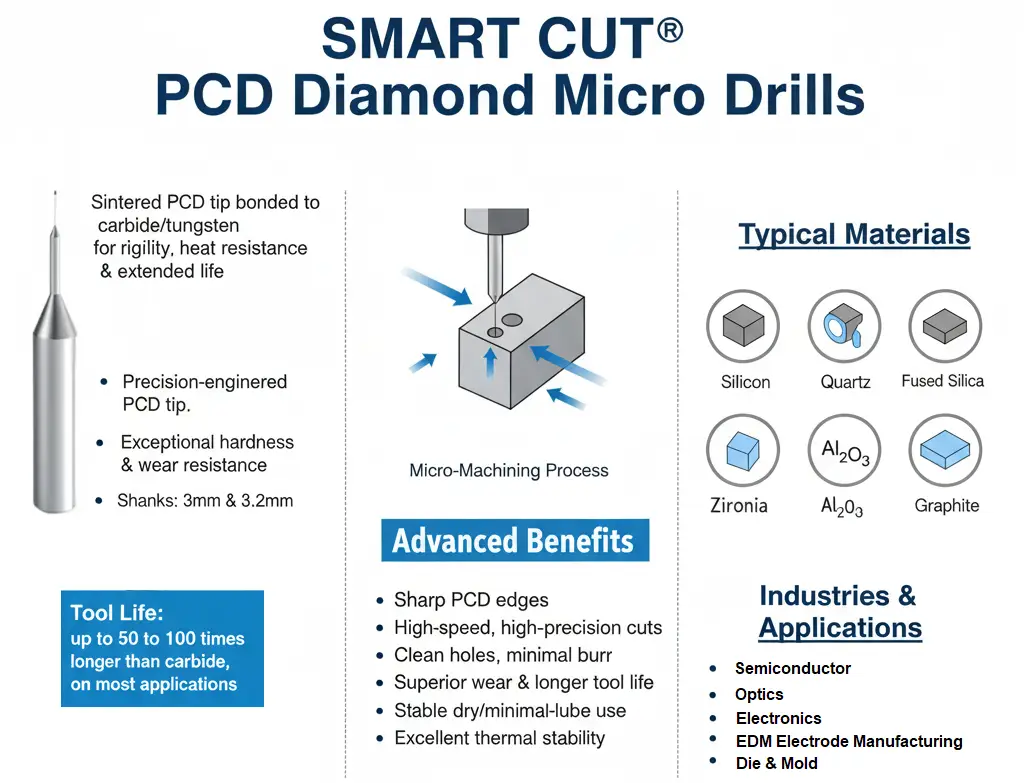
Advantages
- High Abrasion Resistance: PCD is one of the hardest known materials, providing exceptional wear resistance. This quality is particularly beneficial when drilling materials like monocrystalline silicon, quartz, zirconia, and silicon carbide (SiC), which are abrasive and can quickly wear down other types of drill materials.
- Longer Tool Life: Due to their high abrasion resistance, PCD micro drills typically have a much longer life than carbide or other types of drills when used on hard materials. This extended tool life means fewer tool changes, less downtime, and overall cost savings.
- Precision and Consistency: The extreme hardness of PCD allows for very precise cutting edges, which is crucial for applications in the semiconductor industry where accuracy and consistency are critical.
- Superior Surface Finish: PCD tools can achieve a high-quality surface finish, reducing the need for secondary finishing processes. This is particularly beneficial in the semiconductor and die & mold industries, where surface quality can be a key parameter.
- Reduced Thermal Deformation: PCD has a low coefficient of thermal expansion. This means that these drills are less likely to deform under high-temperature conditions, maintaining their dimensional accuracy during high-speed drilling.
- Universal Application: PCD micro drills are effective not just for traditional materials like monocrystalline silicon and quartz, but also for advanced ceramics like Al2O3 (alumina) and other hard-to-machine materials used in the semiconductor and die & mold industries.
- Improved Productivity: Their ability to maintain sharpness and precision over an extended period allows for faster machining speeds and less downtime, thus enhancing overall productivity.
2092016, 2092018, 2092020, 2092022, 2092024, 2092026, 2092028, 2092030, 2092032, 2092034, 2092036, 2092038
Showing 1 – -1 of 12 results Showing all 12 results Showing the single result No results found
Sort by Price low to high
Filters Sort results
Reset Apply
Image | Item Number | Outside Diameter | Head Length | Shank Diameter | Overall Length | Chamfer Angle | Quantity | Get Quote |
|---|---|---|---|---|---|---|---|---|
.016” (0.4mm) | 5mm | (1/8”) 3.2mm or 3mm | 38mm | 130 | Max: Min: 1 Step: 1 | |||
.018” (0.45mm) | 5mm | (1/8”) 3.2mm or 3mm | 38mm | 130 | Max: Min: 1 Step: 1 | |||
.020” (0.5mm) | 7mm | (1/8”) 3.2mm or 3mm | 38mm | 130 | Max: Min: 1 Step: 1 | |||
.022” (0.55mm) | 7mm | (1/8”) 3.2mm or 3mm | 38mm | 130 | Max: Min: 1 Step: 1 | |||
.024” (0.6mm) | 8mm | (1/8”) 3.2mm or 3mm | 38mm | 130 | Max: Min: 1 Step: 1 | |||
.026” (0.65mm) | 8mm | (1/8”) 3.2mm or 3mm | 38mm | 130 | Max: Min: 1 Step: 1 | |||
.028” (0.7mm) | 8mm | (1/8”) 3.2mm or 3mm | 38mm | 130 | Max: Min: 1 Step: 1 | |||
.030” (0.75mm) | 8mm | (1/8”) 3.2mm or 3mm | 38mm | 130 | Max: Min: 1 Step: 1 | |||
.032” (0.8mm) | 8mm | (1/8”) 3.2mm or 3mm | 38mm | 130 | Max: Min: 1 Step: 1 | |||
.034” (0.85mm) | 8mm | (1/8”) 3.2mm or 3mm | 38mm | 130 | Max: Min: 1 Step: 1 | |||
.036” (0.9mm) | 8mm | (1/8”) 3.2mm or 3mm | 38mm | 130 | Max: Min: 1 Step: 1 | |||
.040” (1.0mm) | 8mm | (1/8”) 3.2mm or 3mm | 38mm | 130 | Max: Min: 1 Step: 1 |
2092016,2092018,2092020,2092022,2092024,2092026,2092028,2092030,2092032,2092034,2092036,2092038,

Advantages of
PCD & PCBN Tools
- Good surface finish
- High accuracy
- Longer tool life
- Fast material removal rate
- Lower energy cost
- Eco friendly
- Lower stock management
PCD (Polycrystalline Diamond) is composed of diamond particles that are sintered with a metallic binder at extreme temperatures and pressures, creating the hardest and one of the most abrasion resistant materials used in cutting tools. These inserts are braised on to cutting tools and are used in machining applications in many applications where you find carbide tooling that includes sawing, routing, drilling and profiling to maximize tool life and reduce production cost
Benefits
- Exceptional Process Reliability: Ensures consistent, dependable performance throughout drilling operations.
- Superior Centering Accuracy: Provides precise drill positioning for enhanced accuracy in hole creation.
- Outstanding Stability: Offers robust performance and reduced vibration during drilling.
- Optimized Tool Longevity: Maximizes the lifespan of the tool, reducing the need for frequent replacements.
- Advanced Wear Resistance: Enhances durability against abrasive forces, prolonging tool usability.
- Peak Average Speeds: Achieves high drilling speeds, boosting productivity and efficiency.
- Reduced Processing Time: Cuts down on operation duration, enabling faster completion of tasks.
- Exceptionally Fine Surface Finishes: Delivers high-quality surface conditions post-drilling.
- Minimal Edge Build-Up: Reduces material accumulation at the drill edges, maintaining clean cutting.
- Precision-Engineered Tool Geometry:Tailored design for optimal performance in specific drilling applications.
- Specialized Surface Treatment: Enhances chip removal efficiency, facilitating smoother drilling processes.
- Precise Hole Entry and Exit Quality: Ensures clean and accurate hole beginnings and completions, adhering to tight tolerances.
Application of PCD & Tools
PCD tools are used for processing aluminum and aluminum, aluminum alloys, copper, copper alloy, babbitt metal, wood, wood based fiber materials, aluminum oxide, reinforced floor boards, wear resistant plastic, Bakelite, graphite, stone materials, tungsten carbide, hard cartons. Epoxy resins, Fiberglass composites, Carbon-phenolic, Hard rubber, Plastics, Ceramics (unfired), Graphite
PCBN cutting tools are used for hardened steel, tool steel, mold steel, bearing steel, chilled cast iron, high chromium cast iron, nickel based high temperature alloy, gray cast iron, zinc alloys, sintered tungsten carbide & many other nonferrous materials that are difficult to machine.
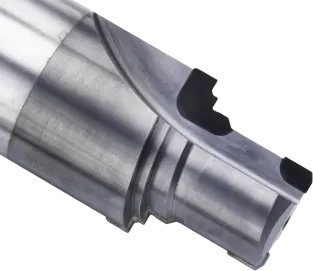
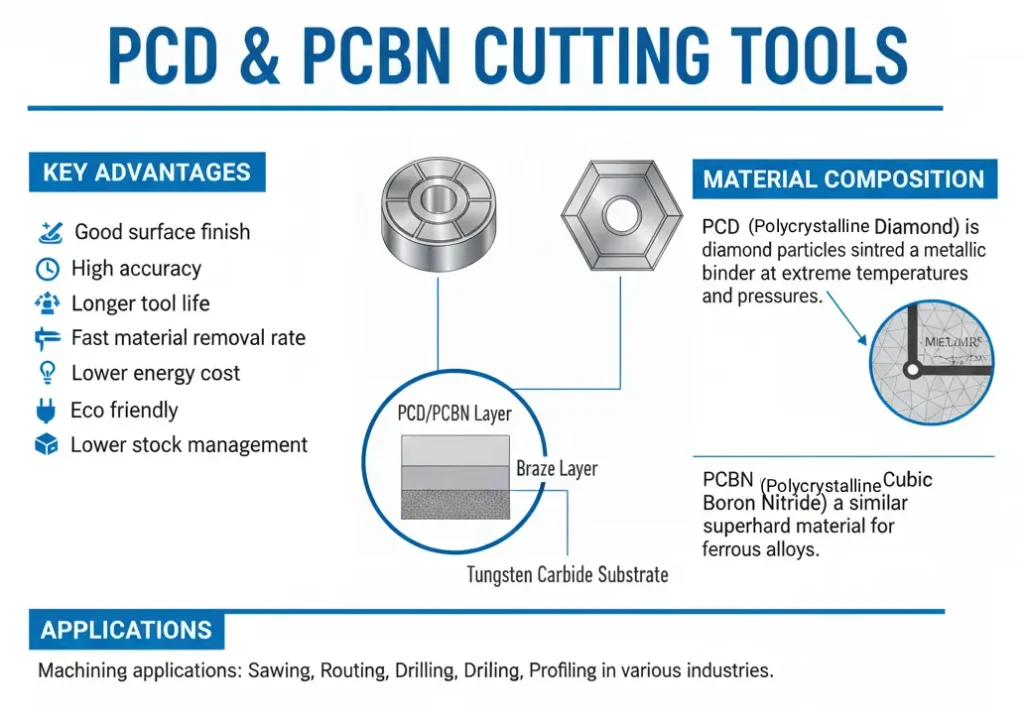
Case Study Continuous Drilling of Small-Diameter Holes in Silicon Using Long-Life PCD Drills
Background
Silicon is widely used in semiconductor, optics, and advanced electronics industries. Machining small-diameter and deep holes in monocrystalline silicon presents several difficulties due to the material’s brittleness and hardness. Traditional tools such as carbide drills, electroplated diamond drills, and monocrystalline diamond drills often face limitations in tool life, machining speed, and hole quality.
Challenges with Conventional Tools
- Carbide tools: Very short service life when drilling small-diameter holes in silicon.
- Electroplated diamond tools: Faster wear due to single-layer coating, limiting their lifespan.
- Monocrystalline diamond drills: Sharp edges but poor chip evacuation. Require frequent step drilling, leading to longer machining times and reduced productivity.
These issues increase downtime, tool replacement costs, and production inefficiency.
Solution: Long-Life PCD Drills
To address these challenges, a polycrystalline diamond (PCD) drill with spiral grooves was developed.
Key Features
- Spiral groove design: Enables effective chip evacuation, reducing the need for step drilling.
- Optimized PCD material: Provides a sharper cutting edge and higher durability than conventional PCD drills.
- High feed capability: Allows continuous drilling under higher machining conditions.
Results Achieved
- Continuous machining of 9,000+ holes in monocrystalline silicon without tool failure.
- Longer service life than carbide, electroplated diamond, and conventional PCD drills.
- Improved hole surface quality due to sharp and stable cutting edges.
- Reduced machining time because fewer drilling steps were required.
Experimental Setup
- Machining unit: Vertical machining center
- Cutting fluid: Emulsion
- Workpiece: Monocrystalline silicon
- Tool diameter: φ0.45 mm
- Spindle speed: 15,000 rpm
- Hole depth: 5 mm
Service Life Comparison
|
Tool Type |
Average Service Life (No. of Holes) |
Hole Quality |
Machining Efficiency |
|---|---|---|---|
|
Carbide Drill |
< 500 |
Poor |
Very Low |
|
Electroplated Diamond Drill |
~1,500 |
Fair |
Low |
|
Monocrystalline Diamond Drill |
~2,500 |
Fair/Good |
Low (due to step drilling) |
|
Conventional PCD Drill |
~4,000 |
Good |
Moderate |
|
Developed PCD Spiral Drill |
9,000+ |
Excellent |
High |
Conclusion
The developed long-life PCD spiral drill significantly improves the drilling of small-diameter holes in silicon. Compared to conventional tools, it delivers:
- Over 3.5 times longer life than conventional PCD drills.
- Superior hole surface finish with reduced chipping.
- Higher productivity through reduced machining time and fewer tool changes.
This makes the solution ideal for industries requiring high precision, long tool life, and cost-efficient continuous drilling of silicon components.
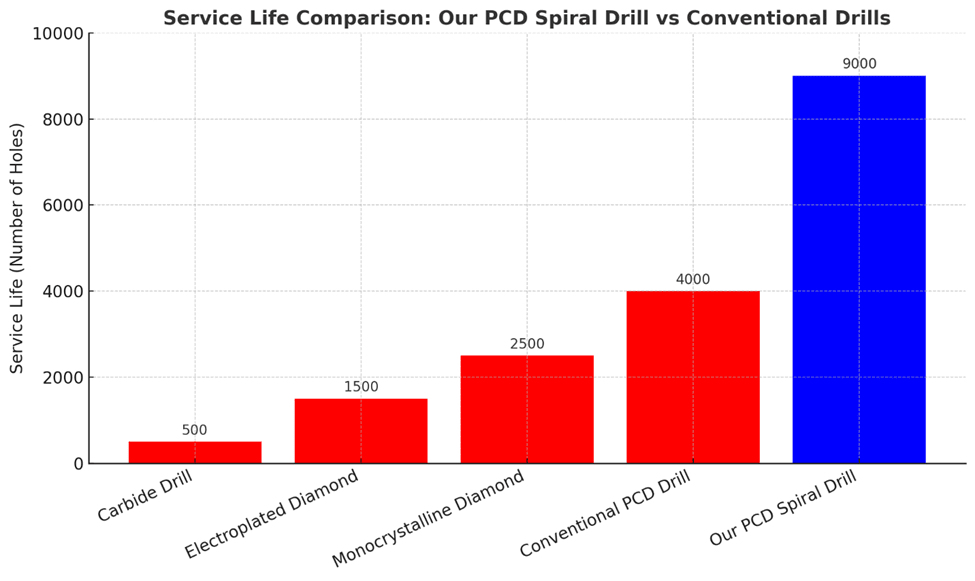
Why Choose Us?
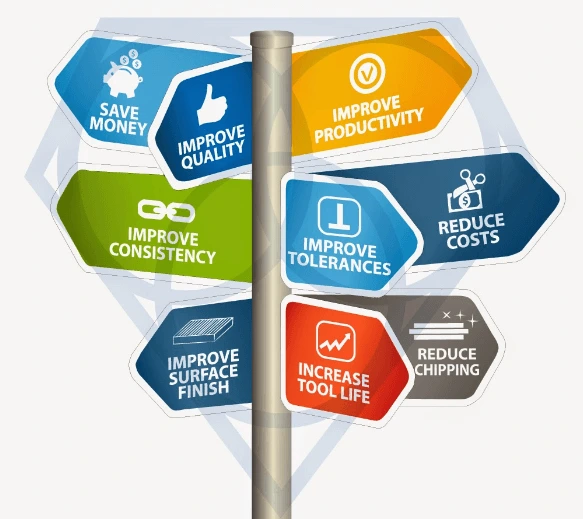
- Unmatched Selection For Many Applications
- Unmatched Technical Support & Expertise
- Superior Quality & Consistency
- Super Technology & innovation
- Immediate Worldwide Delivery
- American Based Manufacturer
-
Custom
Manufacturing - Better Value manufacturer Direct Price
Why Work With Us?
Read More
We understand that your success depends on select the right diamond lapidary blade, and optimizing your parameters to best fit your applications/needs.
Largest Inventory of Diamond Lapidary Blades in the U.S Available in different diameters, wall thicknesses, angles, radiuses, drill depths, mounting types, bond types, diamond mesh sizes, concentrations, bond hardness, tolerances. Custom Manufacturing to fit your particular requirements is available with short lead times and no minimum order quantities.
"ONE OF THE MOST EXPERIENCED COMPANIES IN THE INDUSTRY"
We Are a Partner In Your Success
American Manufacturer
As one of the few remaining independent U.S.Diamond Tool & machine builders. We have the experience & tradition to help you remain at frontier of technology Our experience has been further enhanced by acquiring assets and processes from some of the oldest American tool manufacturers, along with their decades of experience and R& D. This has positioned us as one of the most experienced companies in the industry.
Our unique bond formulations, tool designs, stringent requirements, and utilization of exceptionally high-quality diamonds and raw materials ensure top-notch products that adhere to strict ISO 9000 standards.
Comprehensive Source of Information on Diamond Lapidary Blades
The more you understand about what we can do for you, the better our partnership will be.
On our website you will find the Most Comprehensive Source of Information on Everything you wanted to know about diamond & CBN blades & industrial diamond tools.
Large Inventory & Custom Manufacturing
Experience makes all the Difference
Over the years we have enjoyed working with all types if clients, regardless of size. Proprietary lapidary blade chemistry, precision manufacturing methods, modern quality control methods, allow us to control and regulate the dozens of variables that affect lapidary blade life, quality of cut, surface finish. Reducing and often eliminating additional steps often required after cutting.
Umatched Technical Support
Developing close ties with our customers is the foundation of our business. At the core of our company is a team of world class engineers, knowledgeable customer service personnel here to serve you. Whether is designing or manufacturing a special solution. We will go out of our way to optimizing your process to ultimate level of efficiency.
Advanced Technology
Superior Quality &
Consistency
Our proprietary technology allow us to control and regulate the dozens of variable that affect toolife, quality, & consistency
Expect More From Your Tools
Related Products
SMART CUT® 005DME MCDU
SMART CUT® 005DME Diamond Micro Drills represent a major advancement in precision micro-machining technology, specifically engineered to meet the challenges of drilling hard, brittle, and high-tech materials used across industries such as semiconductor, optics, advanced ceramics, aerospace, and medical device manufacturing.
These drills are widely used in electronics and semiconductor manufacturing for creating microscopic precision holes in wafers, essential for thermal management, electrical connectivity, and overall chip reliability. In optical engineering, they enable accurate hole placement in the assembly of lenses, mirrors, and optical components. In the medical field, they deliver consistent hole geometry and size control, which is vital for implant safety and precision assembly.
They are equally valuable in the aerospace and automotive industries, where components demand extremely tight tolerances and involve materials that are difficult to machine. The accuracy, stability, and repeatability of the SMART CUT® 005DME drills ensure defect-free holes in these critical applications, preventing system failures due to dimensional deviations.
Carbide Micro Drills
SMART CUT® Diamond & CBN Micro Drills, Sintered (Metal Bond)
CVD Micro Drills
Micro Drills
SMART CUT® CVD diamond micro drills are used for drilling micro holes in large variety of hard and brittle materials such as sapphire, high density ceramics, micro-circuit substrates, glass, silicon, various wafers, substrates, tubes etc We offer large variety of standard stock & custom micro drills from 0.05mm diameter to 6mm. with 3mm and 3.2mm shanks, and various heald lengths from 0.5mm and up, and flute specifications.SMART CUT® 010DME (SMCDU)
SMART CUT® 010DME Diamond Micro Drills represent a major advancement in precision micro-machining technology, specifically engineered to meet the challenges of drilling hard, brittle, and high-tech materials used across industries such as semiconductor, optics, advanced ceramics, aerospace, and medical device manufacturing.
These drills are widely used in electronics and semiconductor manufacturing for creating microscopic precision holes in wafers, essential for thermal management, electrical connectivity, and overall chip reliability. In optical engineering, they enable accurate hole placement in the assembly of lenses, mirrors, and optical components. In the medical field, they deliver consistent hole geometry and size control, which is vital for implant safety and precision assembly.
They are equally valuable in the aerospace and automotive industries, where components demand extremely tight tolerances and involve materials that are difficult to machine. The accuracy, stability, and repeatability of the SMART CUT® 010DME drills ensure defect-free holes in these critical applications, preventing system failures due to dimensional deviations.
SMART CUT® Micro & Miniature Diamond Core Drills
SMART CUT® Micro & Miniature Core Drills
Recently Viewed Products

ARE YOU USING RIGHT DIAMOND CORE DRILLS & TOOLS
FOR YOUR APPLICATION?
LET US
HELP YOU
HAVING ISSUES WITH
YOUR CURRENT DIAMOND CORE DRILLS & TOOLS?
Knowledge Center
02
Jun
Learn important diamond drill methodology. understand diamond drill specifications and their differences Selecting the right Diamond Drills/Bits for your application is key to obtaining desired diamond drilling results. Using the Right Diamond Drill will...
02
Jun
How to Properly Use Precision Diamond Drills
Step by step guide on how to properly use and care for your diamond drills. Selecting the right diamond drill/diamond drill bit parameters, often involves a trial and error process. Many which can be avoided...
02
Jun
Diamond Drills Guide
Diamond are used across large variety of industries and applications. This guide explores the wide range of diamond drill types, including hollow core drills designed for removing a cylindrical core, non-core formation drills that grind...
02
Jun
Diamond Tools Guide – Selecting Right Drills & Tools for your application
These tools are used for many different industries grinding and shaping material into different forms, expanding exiting inside diameters, grinding, finishing and polishing existing material. Grinding different angles and radius, creating cavities of various forms,...
02
Jun
Optimizing your Diamond Drilling Operation
There are numerous factors that influence the performance of diamond drills. Understanding these factors helps users select the appropriate diamond drill specifications for their specific applications, optimizing drilling operations to achieve maximum efficiency....
02
Jun
Micro Drilling Guide
Share this Article with Friend or Colleague
In order for you to get the most out of your diamond micro drill or carbide / high speed steel micro drill, we strongly urge you to read...
02
Jun
Selecting Right Drilling Equipment for your Application. What you features & functionality you should look for?
Share this Article with Friend or Colleague
There are hundreds or even thousands of different drilling equipment options. Selecting the right equipment for a specific application involves carefully considering several variables and attributes of the...
03
May
Diamond Core Drill & Drill Trouble Shooting Guide
Learn the most common problems most people have in using diamond drills. How to resolve them and avoid them in first place https://ukam.com/wp-content/uploads/2024/07/diamond-drill-troublehsooting-guide.mp4
Troubleshooting Drilling Problems
Having issues with your diamond drilling operation? This Illustrated...
09
Sep
Understanding & Calculating Return on Investment for Diamond Core Drills & Other Tools
The term "ROI" (Return On Investment) is widely used across industries, often interpreted differently depending on the context. However, few truly understand what ROI represents and its specific implications, particularly in the context of diamond...
09
Sep
Understanding Tradeoffs – Searching for Perfect Diamond Drill & Tool
Choosing the right diamond drill or tool can significantly impact efficiency, cost, and quality. However, this is not a simple and clear-cut process. Selecting the optimal drill or tool involves navigating a complex landscape of...
19
Sep
Why Use Diamond Drills?
Diamond, known as the hardest material on Earth, enables diamond drills and tools to grind away material at a micro (nano) scale. This extreme hardness allows diamond tools to effectively work on materials with a...




